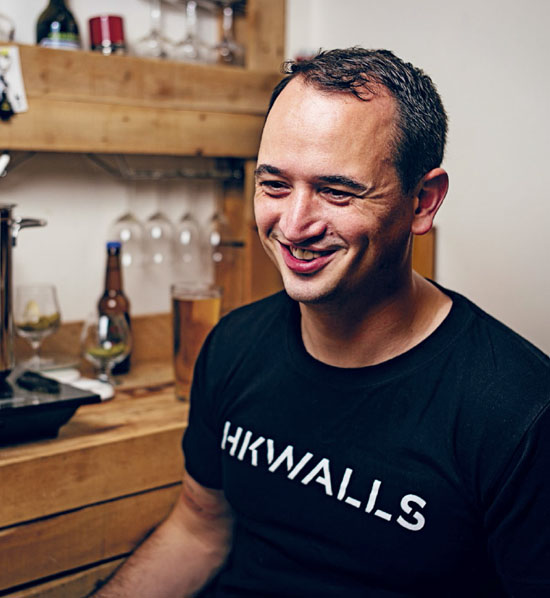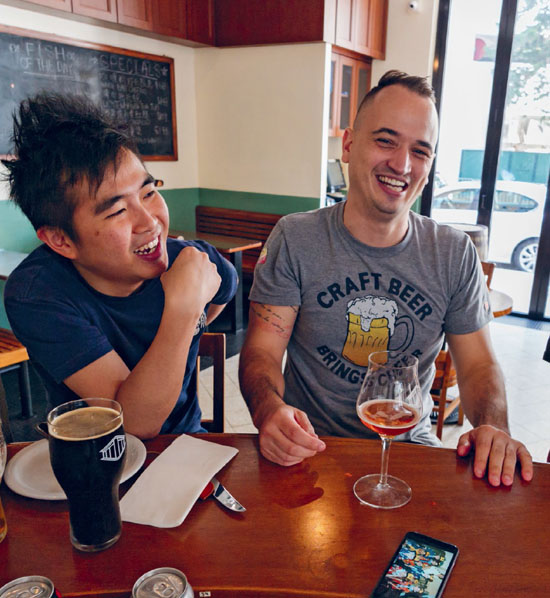
HONG KONG, CHINA
Moving to a foreign country means hankering for a taste of home: New York City–style pizza in Norway, Texas brisket in Turkey, or, for workplace strategist Jordan Kostelac, Bell’s Oberon in Hong Kong.
“I can’t tell you how many bottles of Oberon I drank in my life,” Kostelac says. He grew up in Ohio, and his dad homebrewed for nearly three decades. Kostelac the younger was too young to participate, but the carboy never falls far from the family tree. When he moved to Hong Kong nearly a decade ago, he found an ocean of lagers as far as he could see.
“I wanted stuff I couldn’t get here, so I started making it in my house,” he says. “I was homebrewing out of necessity.”
FUN FACT
In Hong Kong, locals colloquially call craft beer gweilo leung cha—essentially, the white ghost’s herbal tea. Gweilo is Cantonese slang for a Westerner. “It’s this idea that when the Chinese get sick, they drink herbal tea,” Kostelac says. “When we get sick, we drink beer.”
Kostelac bought a five-gallon starter kit, and “as soon as I got my hands on it I went crazy,” he says. Forget San Diego IPAs; he spiced saisons with jasmine, made mulled wine–flavored beer, and mimicked the city’s unofficial drink, black Ceylon tea mixed with condensed milk. “I’ll give it to a local person and they’ll say, ‘You can do that with beer?’ It makes craft beer more of a uniter than a divider.”
Necessity often breeds ingenuity. Kostelac treats his adopted homeland as his homebrewing muse, adding anything and everything Hong Kong can offer to the brew kettle. Ever wonder what candied roast pork (char siu) would taste like in a porter? Well, Kostelac did. From his favorite store, he grabbed a big bowl of “fatty, sugary, amazingly savory” char siu sauce. “They thought I was crazy,” he laughs. The saccharine sauce mostly fermented out of the beer. “It tasted like a perfectly passable porter, but it didn’t taste like char siu.”
He brews in his 300-square-foot apartment, battling Hong Kong’s unwavering weather. “Hong Kongers will tell you Hong Kong has four seasons. That’s not the case. It’s hot, very hot, and sometimes less hot.” He maintains fermentation temperatures with a wine fridge just big enough for five 1-gallon carboys, splitting the batches for experimentation.
Some succeed, some fail. Some failures also wind up succeeding. Take the time Kostelac brewed a blonde ale and added peeled lychees, forgetting to sanitize the fruit. “I didn’t know what I didn’t know,” he says. Those lychees led to a Lactobacillus infection, which turned the blonde tart and tasty. “People just ate the sour up,” he recalls. Mistakes can serve as learning opportunities. When he was teaching a friend to brew, she wondered why he skipped sanitation. “I actually want something that seems bad to happen,” he says. “That process of discovery is fun.”


Kostelac harbors zero aspirations to brew beyond his apartment, and he gives away as much as he brews, clearing space to create his next curiosity. “I don’t care about competition medals. I’m more excited to push the boundaries of what we can do with brewing and brewing techniques.”

ADVICE
Always take notes, especially when you’re just messing around. One brew day, Kostelac created a kitchen-sink batch of leftover liquid malt, added cherry and vanilla flavorings, and French-pressed the hops. The magnificent mutt wowed the judges in the homebrew competition he jokingly entered. “It was this great beer that I honestly can’t reproduce because I forgot to take notes,” he says. Lesson learned.

BREWER SPOTLIGHT
Former Goldman Sachs employee Rohit Dugar helped kick-start Hong Kong’s beer scene with the opening of Young Master Ales in 2013. It celebrates local tastes in beers such as the Cha Chaan Teng Gose, which takes its saline edge from salted limes, and a spring saison flavored with chrysanthemum, osmanthus, and jasmine.